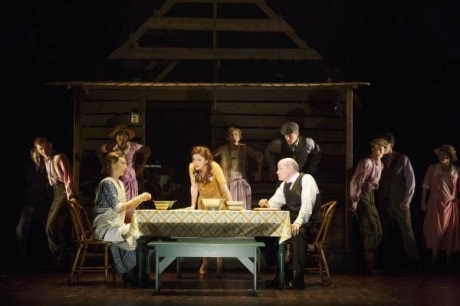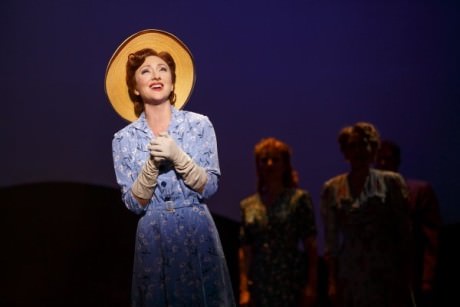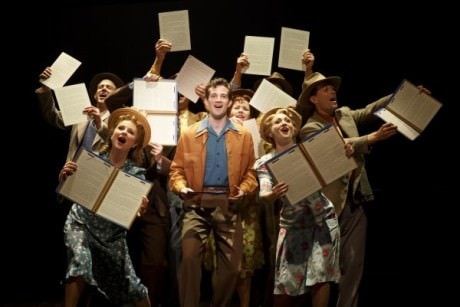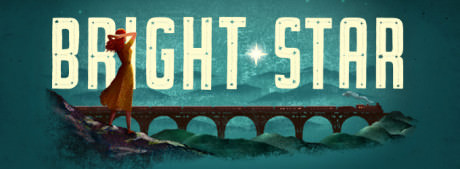Bright Star officially opened last night in its pre-Broadway engagement at The Kennedy Center.
And there is plenty for audiences to like and enjoy.

Let’s start with that banjo. Steve Martin co-wrote the music and story of Bright Star with musician and song writer Edie Brickell. Martin tackled the book, while Brickell handled the lyrics.
Comedian Martin also plays a good banjo, and its distinctive sound, played with pizzazz by Bennett Sullivan, immediately places the characters in their Blue Ridge Mountain home.
Next there’s Carmen Cusack. She plays Bright Star’s lead, Alice Murphy, the wise-cracking editor of the prestigious Asheville Literary Journal.
Cusack lit up the stage with her no-nonsense Alice, a career woman beset by a troubling past. And it’s that troubling past that brings out her powerful voice with its dynamic undertones. Her “Please, Don’t Take Him” and “Whoa, Mama”, sung with her romantic interest, Jimmy Ray Dobbs (Paul Alexander Nolan), rocked the emotional roof.
There’s Josh Rhodes’ choreography, a magnificent blend of scene transforming artistry and character engaging topography. Its ceaseless permutations create a montage of life-moments that provide much-needed verve to an otherwise laidback storyline.
Then there’s that miniature train huffing and puffing over the mountain gorge on its way to fulfill its passengers’ brightest dreams. Train aficionados will definitely have their hallucinations satisfied.
And there’s more, much more, for Bright Star thoroughly entertains its audience with crisp lyrics, a well-told if perhaps predictable story, stirring folksy music, and a host of fine performers, each with the talent to wow.

What Bright Star does not have, however, is a more compelling reason to be beyond its beautiful visions and stirring sounds and gorgeously moving bodies. It’s a period piece written for today, almost as if Martin and Brickell decided that nostalgia for the “good ol’ days” and a simpler, happier time was just what audiences want.
And maybe it is.
World War 2 has ended. G. I. Billy Cane (A. J. Shively) has just returned from the horrors of the war to his North Carolina home, and he’s bubbling with youthful innocence and excitement.
If you are bothered by the juxtaposition of “horrors” and “innocence”, remember: Bright Star is a kind of flashback to a time before PTSD (knowledge of, not existence of) and night sweats. And Shively’s Billy is pure brightness.
And as Billy is a young writer with a big dream, that’s a good thing.
Hometown girl, Margo (Hannah Elless), his childhood friend, has edited his tales and retyped them, making them ready for publication.
You will no doubt guess that these two have got to get together soon, as Elles’ innocence is a definite match for Shively’s.
Billy has to find a journal that will publish his finely written stories, and that’s where Cusack’s Alice Murphy and her Asheville Journal come in.
Billy goes to Asheville and meets Ms. Murphy, who likes his stories, and likes him, but not in that way.
Meanwhile, flashing back 22 years, the young Ms. Murphy is falling in love with the young Mr. Dobbs, whose father does not approve of the match. Dad is the town’s major and a wealthy businessman and Alice is from the hills.
In true Commedia style, it’s the fathers, Stephen Lee Anderson as Daddy Murphy and Michael Mulheren as Mayor Josiah Dobbs, who serve as this tale’s antagonists.

In the flashback scenes, concerning Alice and Jimmy’s young romance, the fathers are “bad” guys, and they give the show its flashes of dramatic tension.
In fact, the mayor is such a sinister son-of-bitch that he earned Mulheren a rousing boo during the ovation. His “A Man’s Gotta Do”, in which he justifies his evil ways in the name of the family business legacy, clarified his old school masculinity.
On the other hand Anderson’s Murphy eventually sees the light. He discards his religious intolerance, apparently by ridding himself of his own patriarchal influences, and becomes a “good” guy by story’s end.
The third dad, Stephen Bogardus as Daddy Cane, is “good” from start to finish. He even has one of the funniest scenes of the evening, a frog hunting escapade under an infamous “Tallahatchie Bridge” (actually, that’s from “Ode to Billy Joe” not “Cain”, a song about another bridge and another something thrown into the water).
Jeff Blumenkrantz as Daryl Ames and Emily Padgett as Lucy also put in excellent comic performances as Ms. Murphy’s two underlings. In fact, the Padgett-led “Another Round”, the musical’s one bar song truly rocked and gave Padgett an opportunity to show off Lucy’s legs with a truly fantastic leg kick.
Walter Bobbie directs Bright Star, doing a masterful job keeping the scenes and their multiple locations concrete while zipping by like lightning.
A strong production team led by scenic designer Eugene Lee, costume designer Jane Greenwood, and lighting designer Japhy Weideman created a beautiful scenography, which director Bobbie manipulated to perfection. The stage pictures are impressive.
Bob Berman provided the music direction for Bright Star while August Eriksmoen did the orchestrations, giving the score variety and each song its own signature.
To be sure, Bright Star’s optimism is palpable. You will feel totally at home wearing its homespun perspective: if you have a dream, stick to it, and it will come true.
And that might be this Broadway bound musical’s biggest question mark.
Bright Star is not a fairytale nor a folktale, but it might make you think that it is based on one: oh, if only life were as simple and good in 2015 as Bright Star sings it to be.
Given the world’s current cynicism, Bright Star‘s tale of sincere and honest people making a successful life in a world controlled by corporate greed seems somewhat lost in space, but you’ll feel good every moment you’re there.
Running Time: 2 hours and 10 minutes with intermission.
Bright Star plays through January 10, 2016 at The Kennedy Center’s Eisenhower Theatre – 2700 F Street, NW, in Washington, DC. For tickets, call the box office at (202) 467-4600, or purchase them online.
From the 2014 Old Globe Theatre production:
https://youtu.be/UsS8VfL2StU
RATING:






“remember: Bright Star is a kind of flashback to a time before PTSD (knowledge of, not existence of).”
It used to be called shell-shock or battle fatigue.